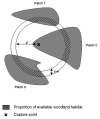Habitat fragmentation impacts mobility in a common and widespread woodland butterfly: do sexes respond differently?
- PMID: 22540674
- PMCID: PMC3430564
- DOI: 10.1186/1472-6785-12-5
Habitat fragmentation impacts mobility in a common and widespread woodland butterfly: do sexes respond differently?
Abstract
Background: Theory predicts a nonlinear response of dispersal evolution to habitat fragmentation. First, dispersal will be favoured in line with both decreasing area of habitat patches and increasing inter-patch distances. Next, once these inter-patch distances exceed a critical threshold, dispersal will be counter-selected, unless essential resources no longer co-occur in compact patches but are differently scattered; colonization of empty habitat patches or rescue of declining populations are then increasingly overruled by dispersal costs like mortality risks and loss of time and energy. However, to date, most empirical studies mainly document an increase of dispersal associated with habitat fragmentation. We analyzed dispersal kernels for males and females of the common, widespread woodland butterfly Pararge aegeria in highly fragmented landscape, and for males in landscapes that differed in their degree of habitat fragmentation.
Results: The male and female probabilities of moving were considerably lower in the highly fragmented landscapes compared to the male probability of moving in fragmented agricultural and deciduous oak woodland landscapes. We also investigated whether, and to what extent, daily dispersal distance in the highly fragmented landscape was influenced by a set of landscape variables for both males and females, including distance to the nearest woodland, area of the nearest woodland, patch area and abundance of individuals in the patch. We found that daily movement distance decreased with increasing distance to the nearest woodland in both males and females. Daily distances flown by males were related to the area of the woodland capture site, whereas no such effect was observed for females.
Conclusion: Overall, mobility was strongly reduced in the highly fragmented landscape, and varied considerably among landscapes with different spatial resource distributions. We interpret the results relative to different cost-benefit ratios of movements in fragmented landscapes.
Figures





References
-
- Clobert J, Danchin E. Dhont AA, Nichols JD (Eds): Dispersal. Oxford University Press, New York; 2001.
-
- Hanski I (Eds) The matrix matters: Effective isolation in fragmented landscapes. Metapopulation ecology. New York: Oxford University Press; - PubMed
-
- Bonte D, Van Dyck H, Bullock JM, Coulon A, Delgado M, Gibbs M, Delgado M, Lehouck V, Matthysen E, Mustin K, Saastamoinen M, Schtickzelle N., Stevens VM, Vandewoestijne S, Baguette M, Barton K, Benton TG, Chaput-Bardy A, Clobert J, Dytham C, Hovestadt T, Meier CM, Palmer SC, Turlure C, Travis JM. Costs of dispersal. Biol Rev. 2012. in press. - PubMed
Publication types
MeSH terms
LinkOut - more resources
Full Text Sources

